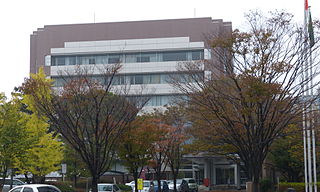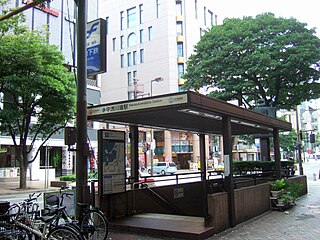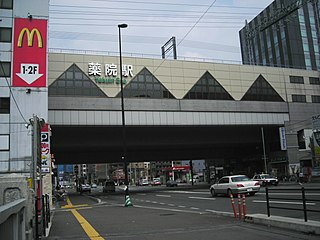
Fukuoka is the sixth-largest city in Japan and the capital city of Fukuoka Prefecture, Japan. The city is built along the shores of Hakata Bay, and has been a center of international commerce since ancient times. The area has long been considered the gateway to the country, as it is the nearest point among Japan's main islands to the Asian mainland. Although humans occupied the area since the Jomon period, some of the earliest settlers of the Yayoi period arrived in the Fukuoka area. The city rose to prominence during the Yamato period. Because of the cross-cultural exposure, and the relatively great distance from the social and political centers of Kyoto, Osaka, and later, Edo (Tokyo), Fukuoka gained a distinctive local culture and dialect that has persisted to the present.

Fukuoka Prefecture is a prefecture of Japan located on the island of Kyūshū. Fukuoka Prefecture has a population of 5,109,323 and has a geographic area of 4,986 km2. Fukuoka Prefecture borders Saga Prefecture to the southwest, Kumamoto Prefecture to the south, and Ōita Prefecture to the southeast.

Hakata-ku (博多区) is a ward of the city of Fukuoka in Fukuoka Prefecture, Japan.

Kasuga is a city located in Fukuoka Prefecture, Japan. As of 31 March 2024, the city had an estimated population of 111,840 in 50874 households, and a population density of 260 persons per km². The total area of the city is 14.145 km2 (5.461 sq mi).

Hakata Station is a major railway station in Hakata-ku, Fukuoka, Japan. It is the largest and busiest railway terminal in Kyushu, and is a gateway to other cities in Kyushu for travelers coming from Honshu by rail travel. The San'yō Shinkansen from Osaka ends at this station.
Nakasu (中洲) is the red-light district which exists between the sandbank of the Naka River and the Hakata River in Fukuoka City, Fukuoka Prefecture, Japan. It is named after a popular, but very short-lived, entertainment quarter of Edo, which existed in the late 18th century. The name "Nakasu" can be translated as "the island in the middle", as Nakasu is an island between two rivers.

The Fukuoka City Subway serves Fukuoka, Japan. It consists of three subway lines, the Kūkō, the Hakozaki Line and the Nanakuma Line.

The Hakozaki Line (箱崎線, Hakozaki-sen) is a subway line, which forms part of the Fukuoka City Subway system in the city of Fukuoka, Japan. It connects Nakasu-Kawabata in Hakata Ward with Kaizuka in Higashi Ward, all within Fukuoka. The line's color on maps is blue. Officially, the line is called Line 2 (Hakozaki Line) (2号線(箱崎線), Ni-gō-sen (Hakozaki-sen)). Like other Fukuoka City Subway lines, stations are equipped with automatic platform gates, and trains are automatically operated by ATO system.

The Nanakuma Line (七隈線, Nanakuma-sen) is a subway line, part of the Fukuoka City Subway system in Fukuoka, Japan. It runs from Hashimoto Station in Nishi Ward to Hakata Station in Hakata Ward, all within Fukuoka. The line's color on maps is green. Officially, the line is called Line 3 (Nanakuma Line) (3号線(七隈線), San-gō-sen (Nanakuma-sen)). Like other Fukuoka City Subway lines, stations are equipped with automatic platform gates, and trains are automatically operated by ATO system.

The Airport Line is a subway line, part of the Fukuoka City Subway system in Fukuoka, Japan. It connects Meinohama, Nishi Ward to Fukuokakūkō, Hakata Ward, all within Fukuoka. The line's color on maps is orange. Officially, the line is called Line 1 . The line has a through service with JR Chikuhi Line. Like other Fukuoka City Subway lines, stations are equipped with automatic platform gates, and trains are automatically operated by ATO system. However, JR train cars are operated manually.

Nakasu-Kawabata Station is a subway station on the Hakozaki Line and Kūkō Line located in Hakata-ku, Fukuoka in Japan. The station's symbole mark is Chinese characters "中" and "川" look like Happi's motif.

Tenjin Station is a subway station located in Chūō-ku, Fukuoka, Japan. Its station symbol is 5 green dots arranged in a circle, representing a plum blossom, it is Tenmangū (a.k.a.Tenjin)'s symbol. The station is located directly under Meiji-Street in Tenjin, Fukuoka. A large underground shopping mall reaches from Tenjin Station on the Kūkō Line to the Tenjin-Minami Station on the Nanakuma Line.

Nishitetsu-Fukuoka (Tenjin) Station is a railway station in Chūō-ku, Fukuoka, operated by the private railway operator Nishi-Nippon Railroad, and has station number T01.

Yakuin Station is a passenger railway station located in Chūō-ku, Fukuoka. The above ground portion is operated by the private transportation company Nishi-Nippon Railroad (NNR), and has station number T02, and the underground portion is operated by the Fukuoka City Subway The subway station's symbol mark is a mortar and pestle, because 薬院 means medicinal plant botanical garden in Japanese.

Zasshonokuma Station is a passenger railway station located in Hakata-ku, Fukuoka Fukuoka Prefecture, Japan. It is operated by the private transportation company Nishi-Nippon Railroad (NNR), and has station number T07.

Sakurazuka Station (桜坂駅) is a subway station on the Fukuoka City Subway Nanakuma Line in Chūō-ku, Fukuoka in Japan. Sakurazuka is literally "cherry blossom slope" in Japanese. So its station symbol is a picture of seven cherry blossom petals in pink is fluttering in the wind.

Nanakuma Station (七隈駅) is a subway station on the Fukuoka City Subway Nanakuma Line in Jōnan-ku, Fukuoka in Japan. Its station symbol is a picture of seven hexagon in violet.

The Fukuoka Subway 3000 series and 3000A series (福岡市交通局3000系・3000A系) are electric multiple unit train types operated by Fukuoka City Transportation Bureau on the Nanakuma Line in Fukuoka, Japan.

Kushida Shrine Station is a subway station on the Fukuoka City Subway Nanakuma Line in Hakata-ku, Fukuoka in Japan.

The Fukuoka Subway 4000 series (福岡市交通局4000系) is an electric multiple unit (EMU) train type on order by the Fukuoka City Transportation Bureau for use on the Hakozaki Line and Kūkō Line in Fukuoka, Japan.




















